If you’ve never had brioche bread before, then you are in for a treat. This French bread is considered a Viennoiserie, meaning while it’s bread, it has the characteristics of a pastry as the dough is enriched with butter and eggs, leading to a rich and tender crumb.
This bread is surprisingly easy to make for home bakers as the most difficult part is being patient as you wait for the dough to proof. It tastes incredibly delicious, and with only a few simple steps, you’ll have bakery-quality brioche at home in no time. For another easy bread recipe, try my homemade french bread, easy artisan bread, or focaccia recipe.
What You Need to Make This Recipe
Yeast — always double-check the expiry date of your yeast. If it is past its best before date, it’s best to pick up a new packet of yeast at the store.
Flour — all-purpose flour is perfect for making loaves of brioche bread as it’ll give you a soft and fluffy crumb. While you can use bread flour, it’ll result in a slightly chewier loaf of brioche.
Eggs — for a rich loaf of bread, don’t skimp on the eggs. You can use any eggs you have on hand, but if you would like a deeper yellow color to your loaves, use eggs that have deep orange yolks.
Butter — be sure to buy unsalted butter and not salted butter for your brioche bread. Salted butter does not have a consistent amount of salt across different brands, so measuring salt separately for the brioche dough ensures it’s not overly salty. Also, make sure the butter is at room temperature, which means it’s soft enough so when you press into it, your finger leaves a dent. This way, it’ll incorporate into the dough seamlessly when you add a tablespoon at a time.
How to Make Brioche Bread
1. In the bowl of a stand mixer, combine the yeast with a portion of the flour, milk, and sugar.
2. Loosely cover the mixing bowl and let stand at room temperature until foamy.
3. Add the remaining flour, salt, and sugar to the mixing bowl.
4. Add the eggs to the bowl.
5. With dough hook attachment, beat on low speed until well combined and knead until the dough is shiny and elastic, about 10 to 12 minutes. Gradually add the butter a tablespoon at a time, allow the butter to incorporate into the dough before adding the next tablespoon.
6. Increase the speed to medium-low and continue kneading until the dough is smooth and elastic. Then, cover the bowl and let rise until doubled in size.
7. Punch down the dough and turn it out onto a lightly floured surface. Divide the dough in half, cut the half into 3 equal pieces, and roll each piece into a 9-inch long rope. Braid the ropes together, pinching ends together to seal. Tuck the ends under and place the dough in a buttered loaf pan. Repeat with the remaining dough half before covering to let rise until doubled in size.
8. Brush the risen loaves with egg wash and bake for 35 minutes or until deep golden brown. Let the baked brioche bread cool in the loaf pans for 5 minutes before transferring to a wire rack.
Pro Tips for Making This Recipe
- The time it takes for your dough to rise depends on the temperature of your kitchen. The ideal temperature for dough rising is 75 to 78F.
- If your kitchen is cold, you can place your burger buns dough in an oven that is OFF with the light on.
- Make sure the milk is between 110 to 120F as milk that’s too hot will kill the yeast, and milk not warm enough won’t activate the yeast.
- Avoid adding too much flour by measuring your flour correctly! Adding too much flour to the recipe is the most common mistake leading to dense bread. The best way to measure flour is by using a scale. If you don’t have one, then fluff your flour with a spoon, sprinkle it into your measuring cup, and use a knife to level it off.
- Eggs need to be at room temperature and not fridge-cold as they’ll incorporate better into the brioche dough. Place the eggs into a bowl of warm water for a couple of minutes to quickly bring them to room temperature if you have forgotten to take them out of your fridge ahead of time.
- To tell if your dough is ready to be baked, gently press the dough to form an indent. If the indentation stays or springs back a tiny bit, the dough is ready to be baked. If it bounces back fully, then it needs more time.
- When you poke the dough, and it deflates, it means the dough is over-proofed. You will have to reshape the dough and start again, or your brioche bread will deflate once baked.
- To tell if the bread is baked through, check that the internal temperature is 190°F.
- Making a sponge takes extra time but it enhances the flavor of the baked loaves. If you want to save some time, skip adding the flour in step 1 and bloom the yeast until the mixture is foamy, about 10 minutes. Add all 6 cups of flour in step 2.
- If you want to adapt this to another use then check out my brioche buns recipe.
Frequently Asked Questions
Can I make this without a stand mixer?
If you do not have a stand mixer, you can use a hand mixer but make sure to use the dough hook attachments. Alternatively, you could knead brioche bread by hand, but it’ll be labor-intensive as the high-fat content means it’ll take longer to form gluten structure. The dough will be very sticky to start, so it’ll be challenging to knead, but it’s possible. Make sure to knead the dough on a lightly floured surface. Knead the dough by pushing it down and outward using the palms of your hands, fold it in half, and repeat until the dough is smooth. It will take approximately twice as long to knead by hand as with a stand mixer.
What makes a brioche different from most breads?
Most bread recipes call for water, flour, salt, and yeast. However, brioche has a generous amount of eggs, milk, and butter which enriches the dough leading to a loaf that is much more moist, soft, and rich in comparison. This brioche bread recipe also tastes sweeter than traditional bread.
Do I have to braid the dough?
If you want to try a different method, nantaise brioche loaf is another classic way of shaping the dough. It’s also called a faux-braided loaf as it looks similar without braiding. Divide each half of the dough into 8 equal pieces and roll them into balls instead of 3 logs. Then, place the balls into the loaf pan in a zig-zag shape. The result will be a loaf that looks like a braid but is similar to a pull-apart bread.
How do I store this?
You can keep brioche loaf at room temperature for 2 days or in the fridge for 2 weeks. This brioche recipe has a longer shelf life thanks to all the butter added to the dough.
How do I freeze this?
You can freeze the brioche loaves in an airtight container or a freezer-safe bag for up to 2 months. To thaw, place in the refrigerator overnight or on the counter until its reached room temperature.
If you’ve tried this Brioche Bread recipe, then don’t forget to rate the recipe and let me know how you got on in the comments below, I love hearing from you!
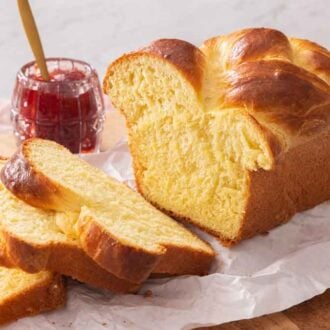
Brioche Bread
Video
Equipment
- Stand mixer
- Loaf pans
Ingredients
- 6 cups all-purpose flour divided (720g)
- ¾ cup warm milk 110-120°F (180mL)
- 6 tablespoons granulated sugar divided (75g)
- 1 0.25-oz. packet active dry yeast (2¼ teaspoons)
- 7 large eggs divided
- 2½ teaspoons salt
- 1¼ cups unsalted butter softened and cubed (284g)
- 1 tablespoon water
Instructions
- To make the sponge, in the bowl of a stand mixer, whisk together 1 cup flour, the milk, 1 tablespoon sugar, and the yeast until combined. Loosely cover, and let stand at room temperature, until foamy, about 45 minutes.
- Once the sponge is ready, add 6 eggs, the salt, the remaining 5 cups flour, and the remaining 5 tablespoons sugar. With dough hook attachment, beat on low speed until well combined, about 2 minutes, scraping down the bowl as needed. Continue kneading until the dough is shiny and elastic about 10 to 12 minutes.
- With the mixer on low speed, gradually add in the butter 1 tablespoon at a time, waiting until it is fully incorporated before adding the next tablespoon. Once all of the butter is incorporated, increase the speed to medium-low and continue kneading until the dough is smooth and elastic, about 8 minutes more. (It should be tacky but not stick to a clean finger when quickly tapped.) Scrape the dough down into the bowl. Cover, and let rise in a warm place until doubled in size, about 1 hour.
- Butter 2 (8x4-inch) loaf pans.
- Punch down the dough and turn out onto a lightly floured surface. Divide the dough in half. Working with one half at a time, cut the dough into 3 equal pieces, and roll each piece into a 9-inch long rope. Braid the ropes together, pinching ends together to seal. Tuck the ends under and place in a buttered loaf pan. Repeat with the remaining dough half. Loosely cover, and let rise in a warm place until doubled in size, about 1 hour.
- While loaves are rising, preheat the oven to 375F.
- In a small bowl, whisk together the water and remaining 1 egg until smooth. Brush the risen loaves with egg wash.
- Bake for 35 minutes or until deep golden brown, covering with aluminum foil after 25 minutes if the top is browning too quickly. Let the bread cool in the pans for 5 minutes. Remove from pans, and continue cooling on a wire rack. Serve warm or at room temperature. Store cooled bread in an airtight container for up to 1 week, or slice and freeze in a freezer bag for up to 2 months.
Notes
- The time it takes for your dough to rise depends on the temperature of your kitchen. The ideal temperature for dough rising is 75 to 78F.
- If your kitchen is cold, you can place your burger buns dough in an OFF oven with the light on.
- Make sure the milk is between 110 to 120F as milk that’s too hot will kill the yeast, and milk not warm enough won’t activate the yeast.
- Avoid adding too much flour by measuring your flour correctly! Adding too much flour to the recipe is the most common mistake leading to dense bread. The best way to measure flour is by using a scale. If you don’t have one, then fluff your flour with a spoon, sprinkle it into your measuring cup, and use a knife to level it off.
- Eggs need to be at room temperature and not fridge-cold as they’ll incorporate better into the brioche dough. Place the eggs into a bowl of warm water for a couple of minutes to quickly bring them to room temperature if you have forgotten to take them out of your fridge ahead of time.
- To tell if your dough is ready to be baked, gently press the dough to form an indent. If the indentation stays or springs back a tiny bit, the dough is ready to be baked. If it bounces back fully, then it needs more time.
- When you poke the dough, and it deflates, it means the dough is over-proofed. You will have to reshape the dough and start again, or your brioche bread will deflate once baked.
- To tell if the bread is baked through, check that the internal temperature is 190°F.
- Making a sponge takes extra time but it enhances the flavor of the baked loaves. If you want to save some time, skip adding the flour in step 1 and bloom the yeast until the mixture is foamy, about 10 minutes. Add all 6 cups of flour in step 2.



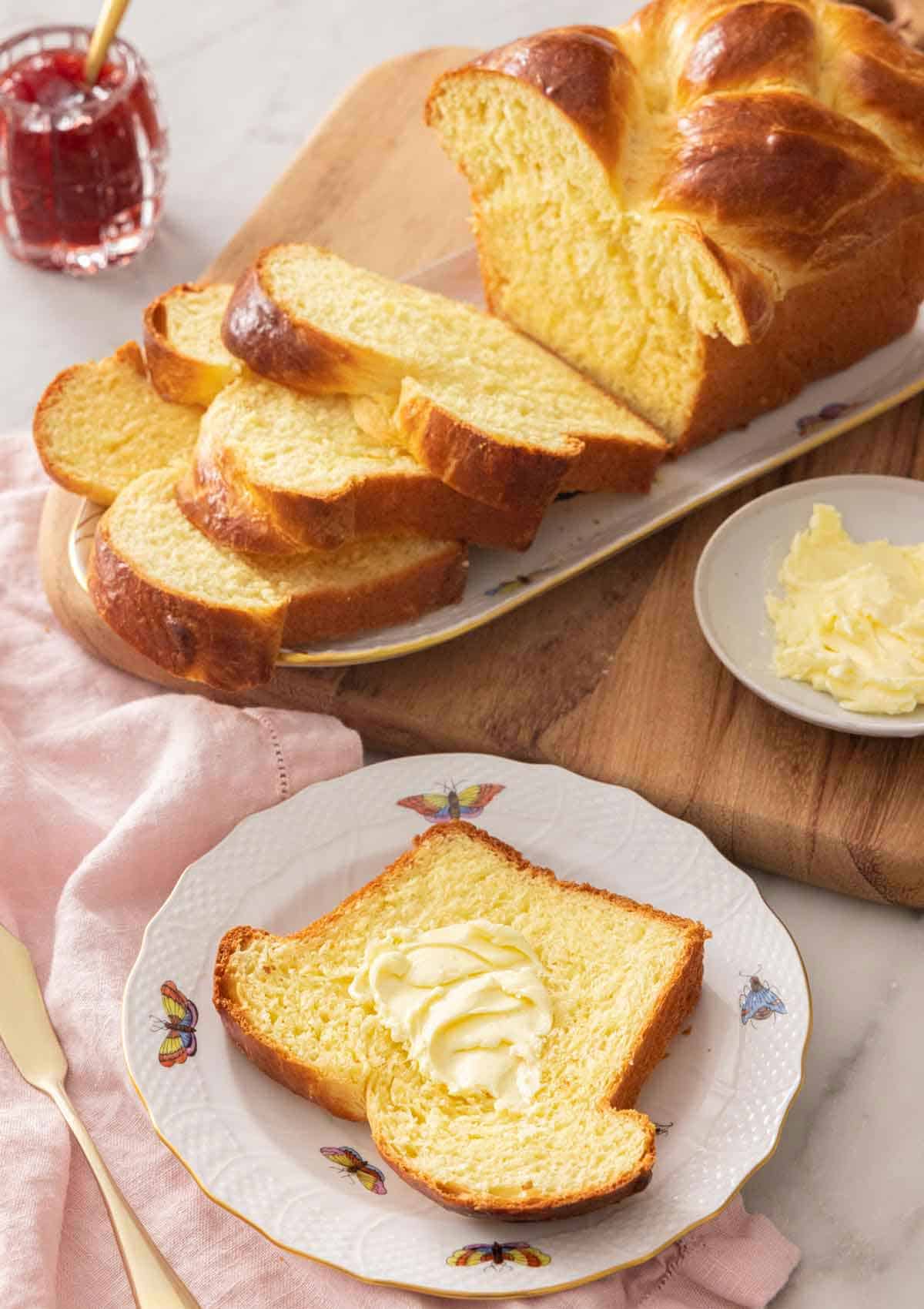
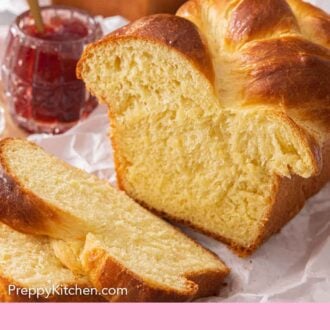
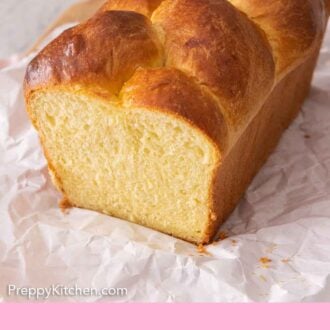
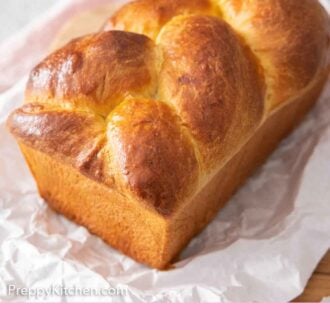
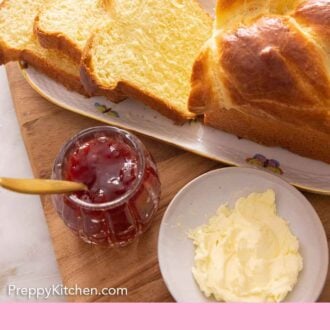
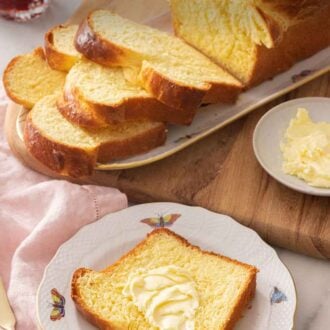
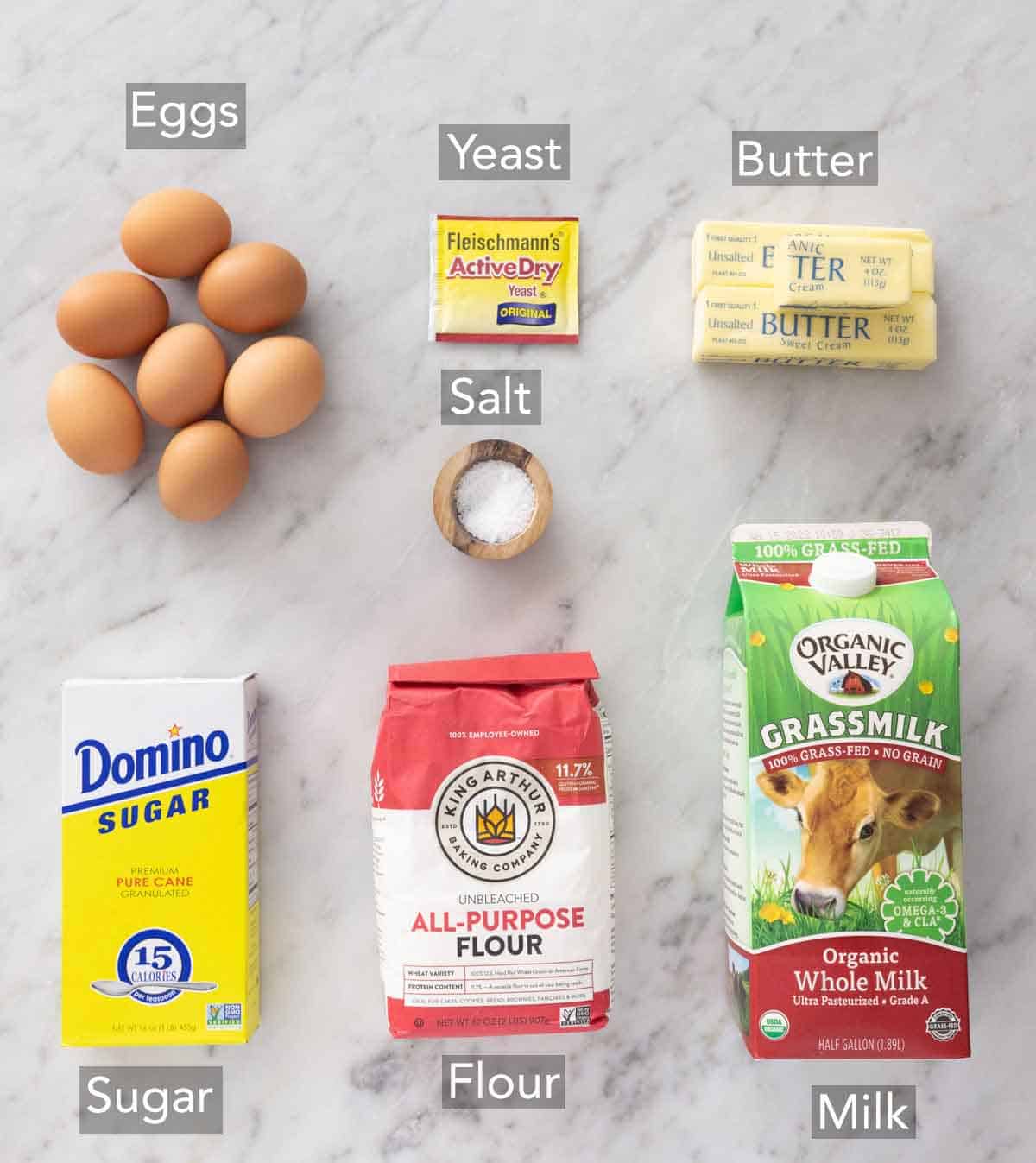
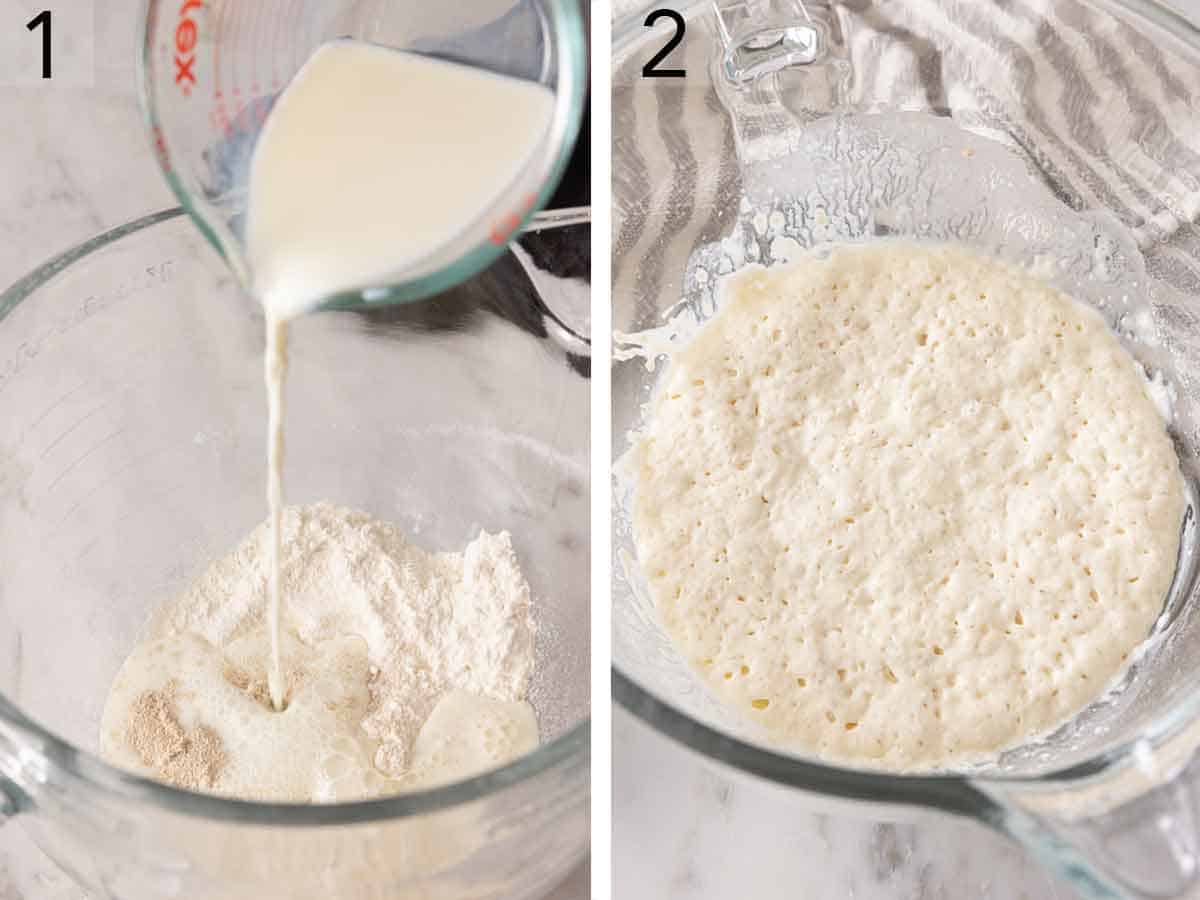
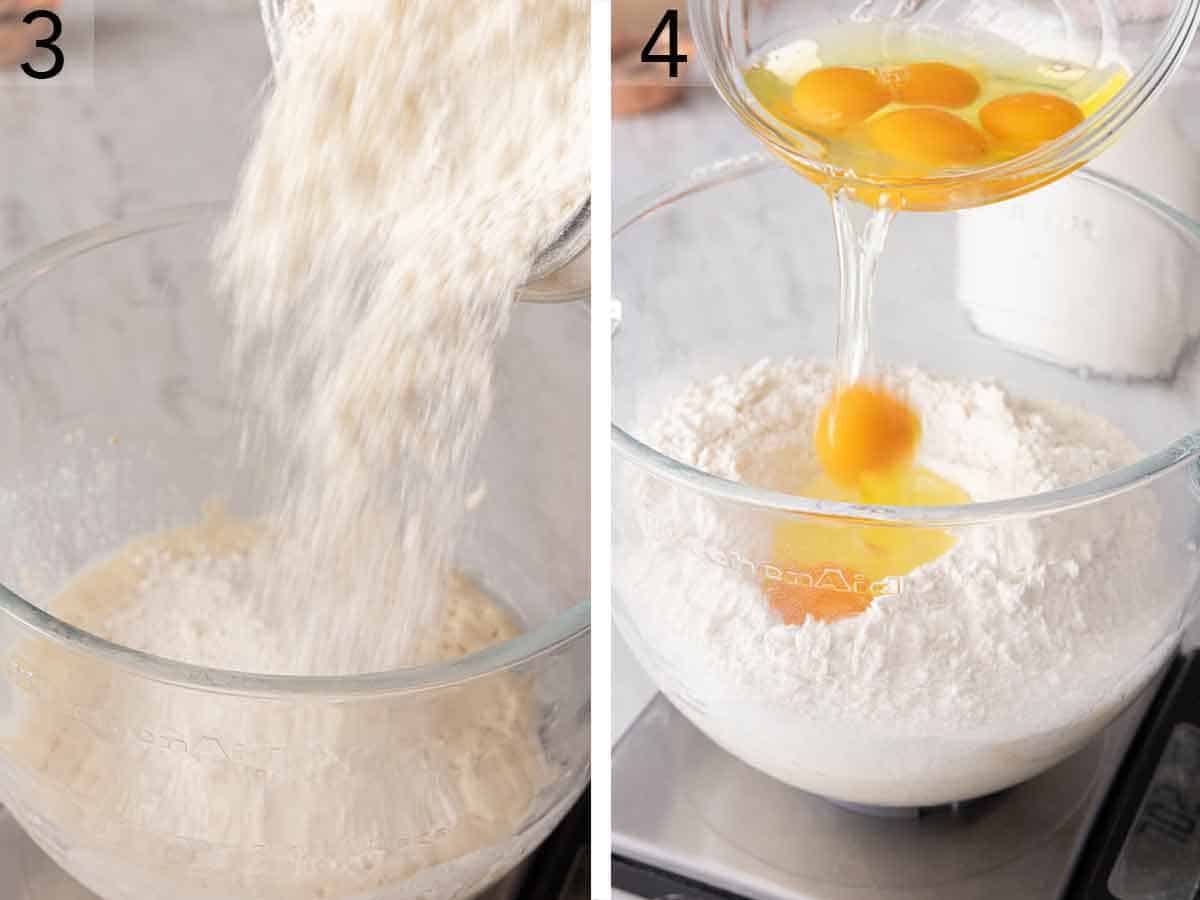
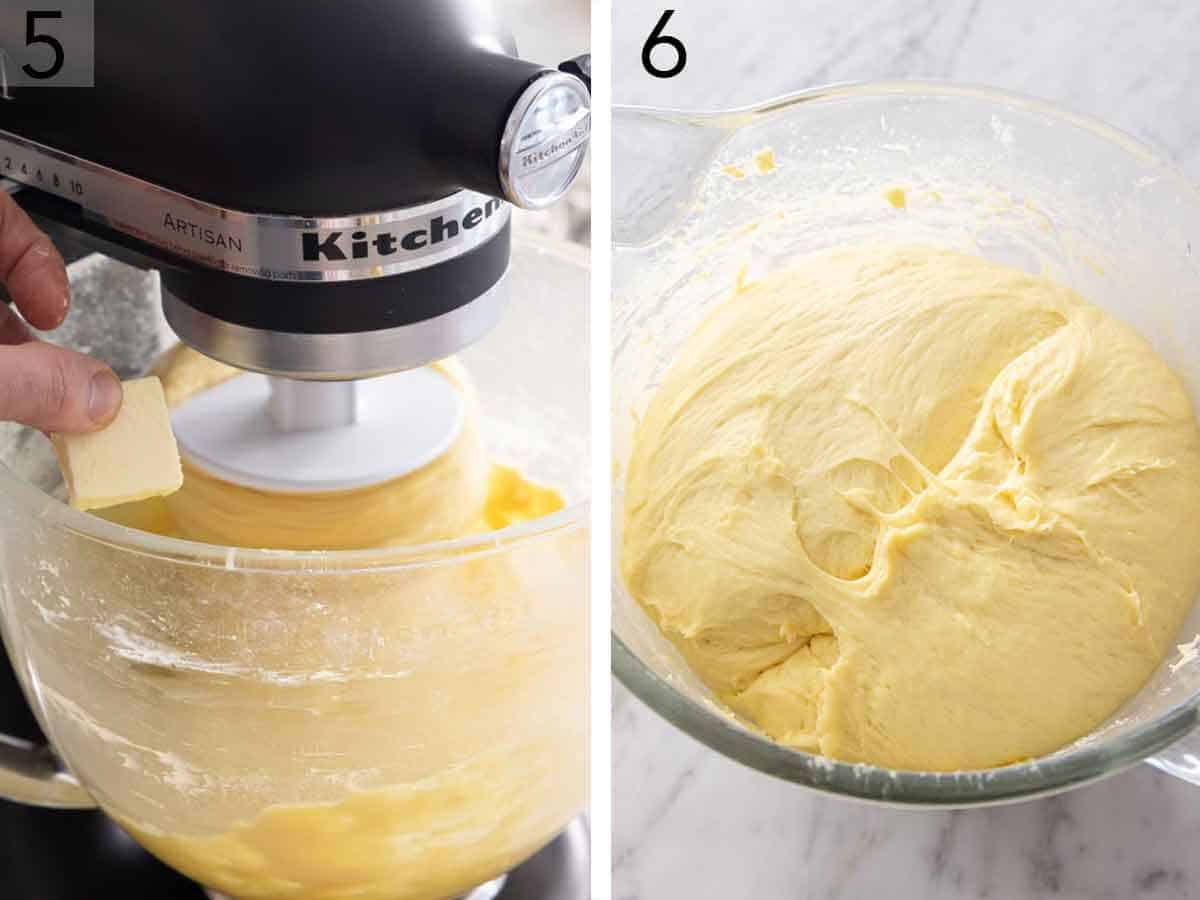
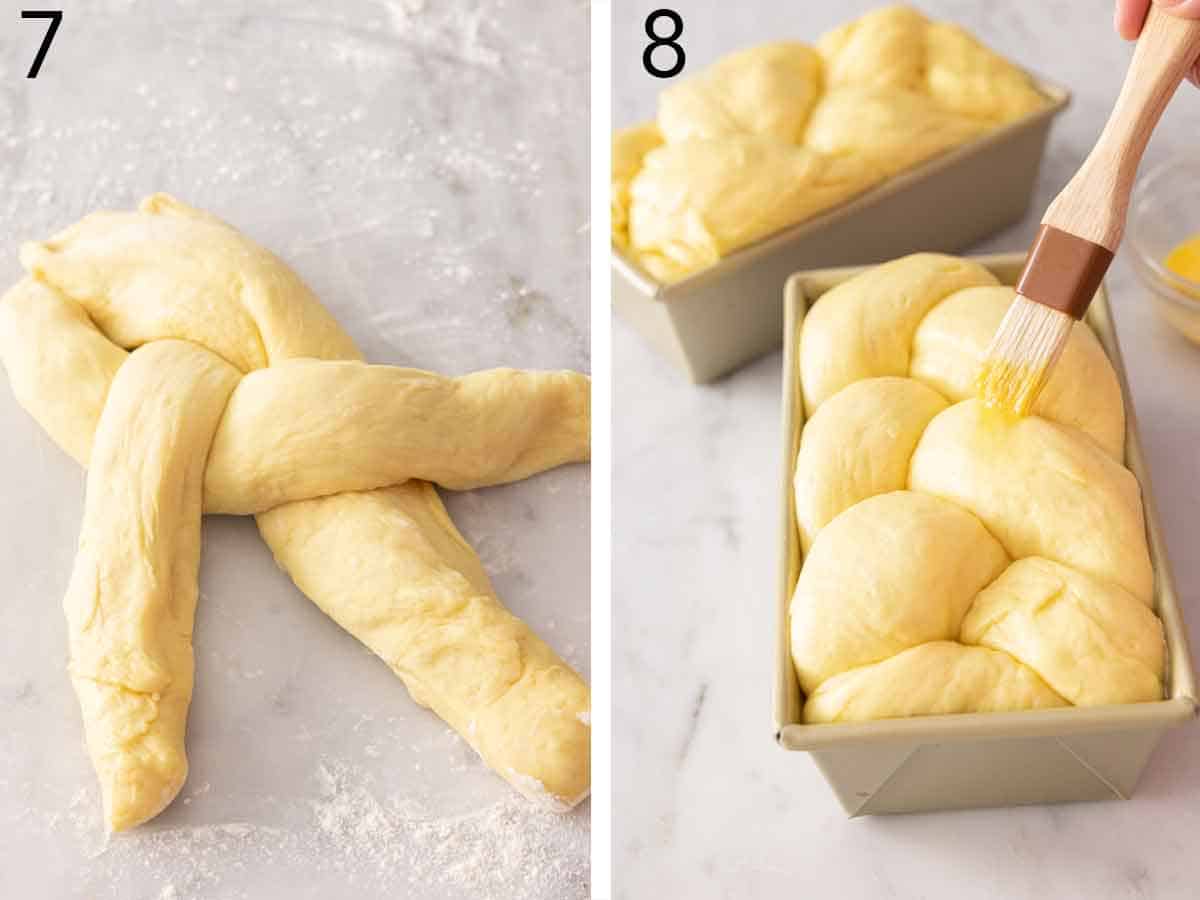
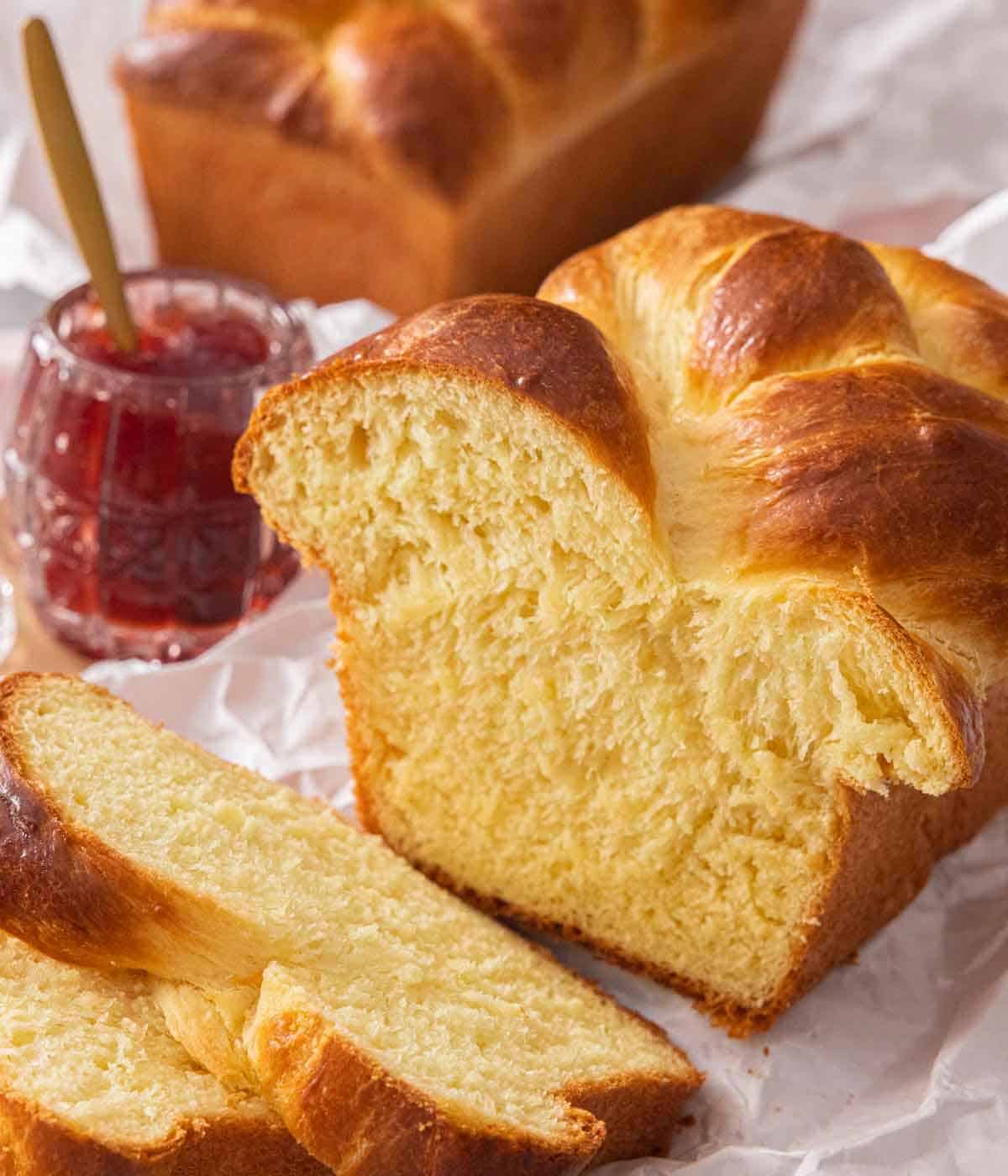
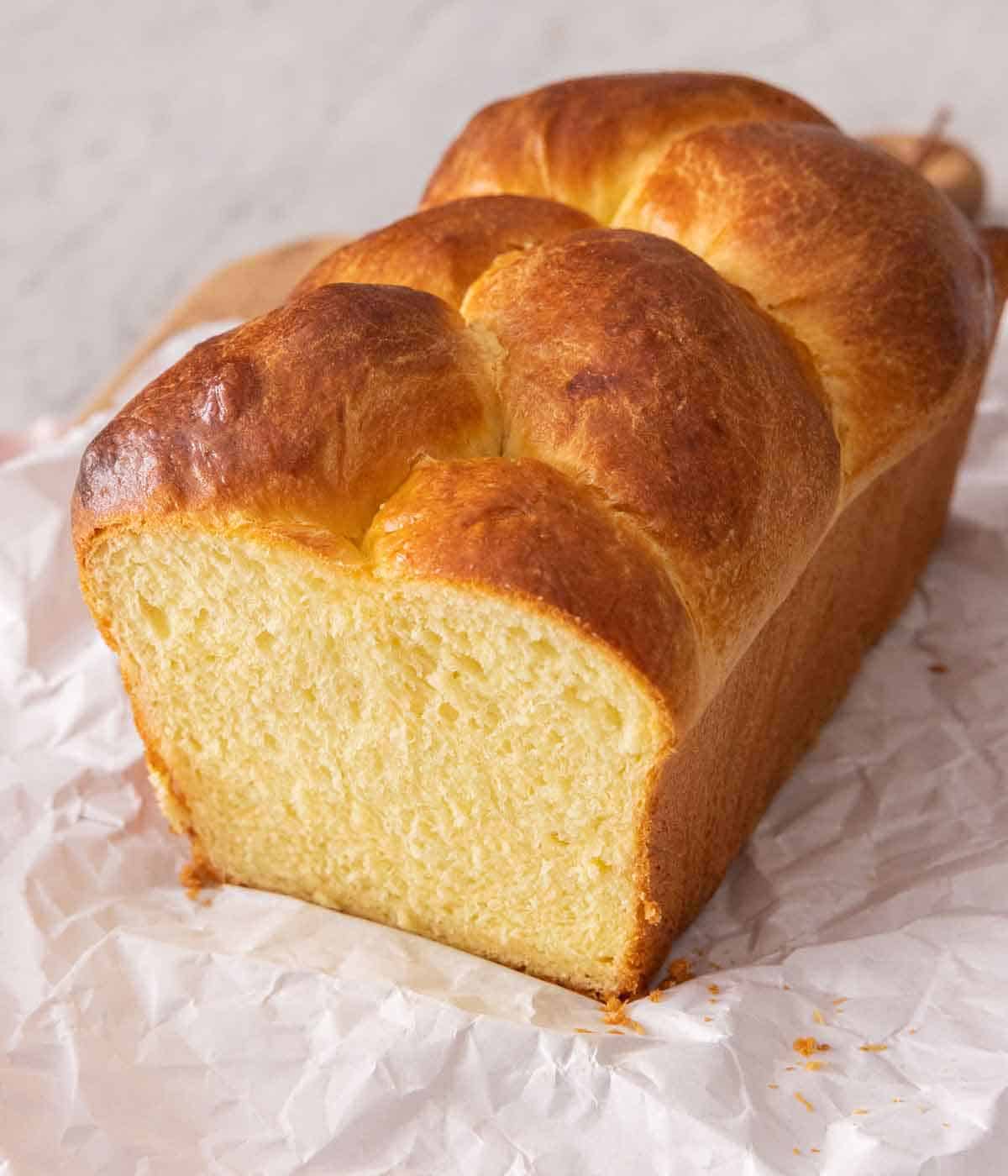
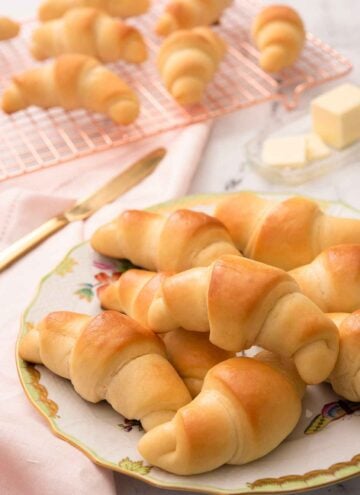
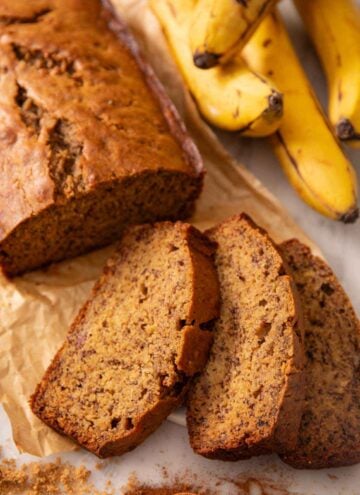

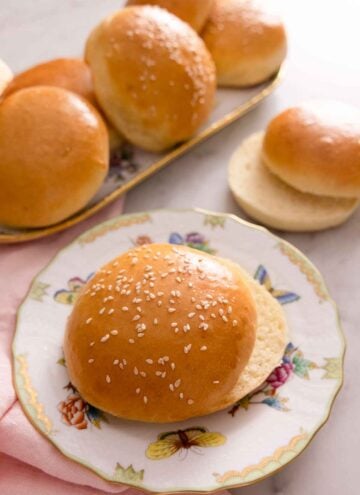


Sakina says
This was great. I put my dough in the fridge overnight to rise and it tripled in size. Made two wonderful loafs one for the week, which probably will be like 3 days.
Wesley says
I made it from the YouTube video twice. I ended up ordering the cookbook. I was hoping the brioche recipe was in it. Glad I found this web site as it makes it easier to follow than the video. Thank you